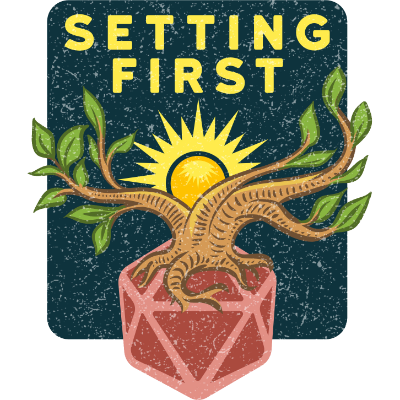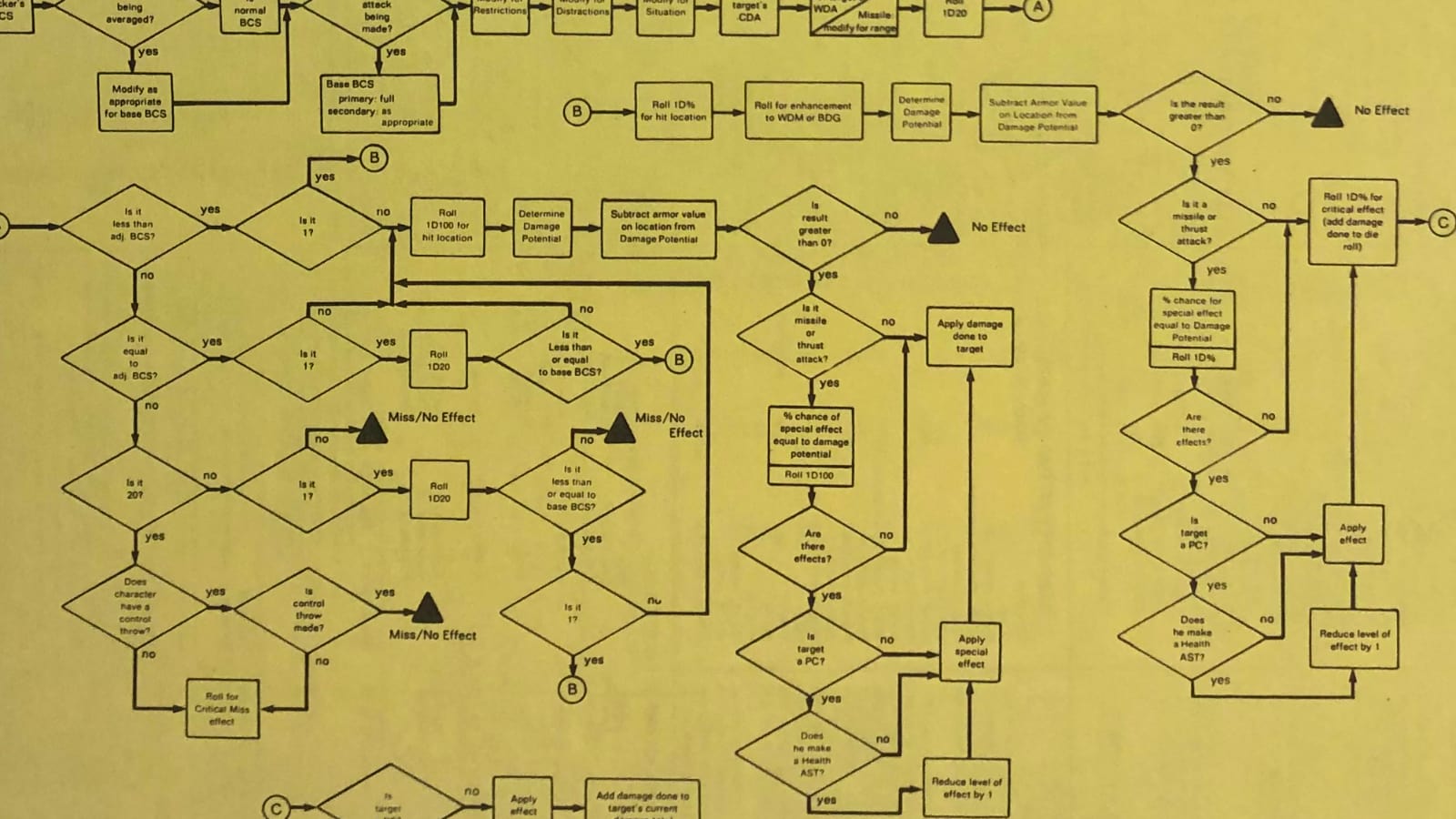
My understanding of believability in roleplaying games, particularly with regard to violence, has shifted over the years.
I posted this article in March, 2023, and created a video version in January, 2024. You can either read the post below or watch it in video form.
Crunch = Realism
It took me a while to commit to purchasing Aftermath! Repeated treks to the local game store had given me plenty of exposure to the game. And by exposure I mean I’d looked at the back of that yellow, black and white box many times, eagerly poring over the breathless marketing copy that asked “Is it the sunset of the earth or the sunrise of a brave new world?”
I mean, come on. How could I resist? Mind you, it was the summer of 1983, a benighted pre-Internet age when one had to search hard to find useful information about anything, usually with limited success. So I was going on gut instinct and the visual trappings of that boxed set. I hadn’t encountered any reviews of Aftermath! and nobody I knew had played it. But I was eager to find a post-apocalypse game that didn’t go full gonzo in the way that Gamma World did.
As it turned out, the mechanics were right in my wheelhouse: nice and crunchy. By way of RuneQuest I was already a disciple of what I thought of as realism in roleplaying games, and Aftermath! committed itself even more firmly to that ideal as I understood it at the time. The combat mechanics were very involved, from initiative to number of actions in a round to damage calculations.
After spending a few weeks to get a firm grip on the mechanics and create the foundation for a campaign set in my home town, I unleashed Aftermath! on my friends. We played the hell out of that game, and along the way I killed a good many player characters. Hey, this was a realistic game, and combat was deadly. So of course the body count was high.
It didn’t help PC survivability that there were so many dangers in my campaign. The Bus Commandos terrorized everyone with their .50-cal machinegun-fitted transit busses. The High School Bandits could strike at any time, then hole up in their hillside fortress. As you can imagine, those PCs that survived were always paranoid, armed to the hilt, and ready to shoot first and ask questions later.
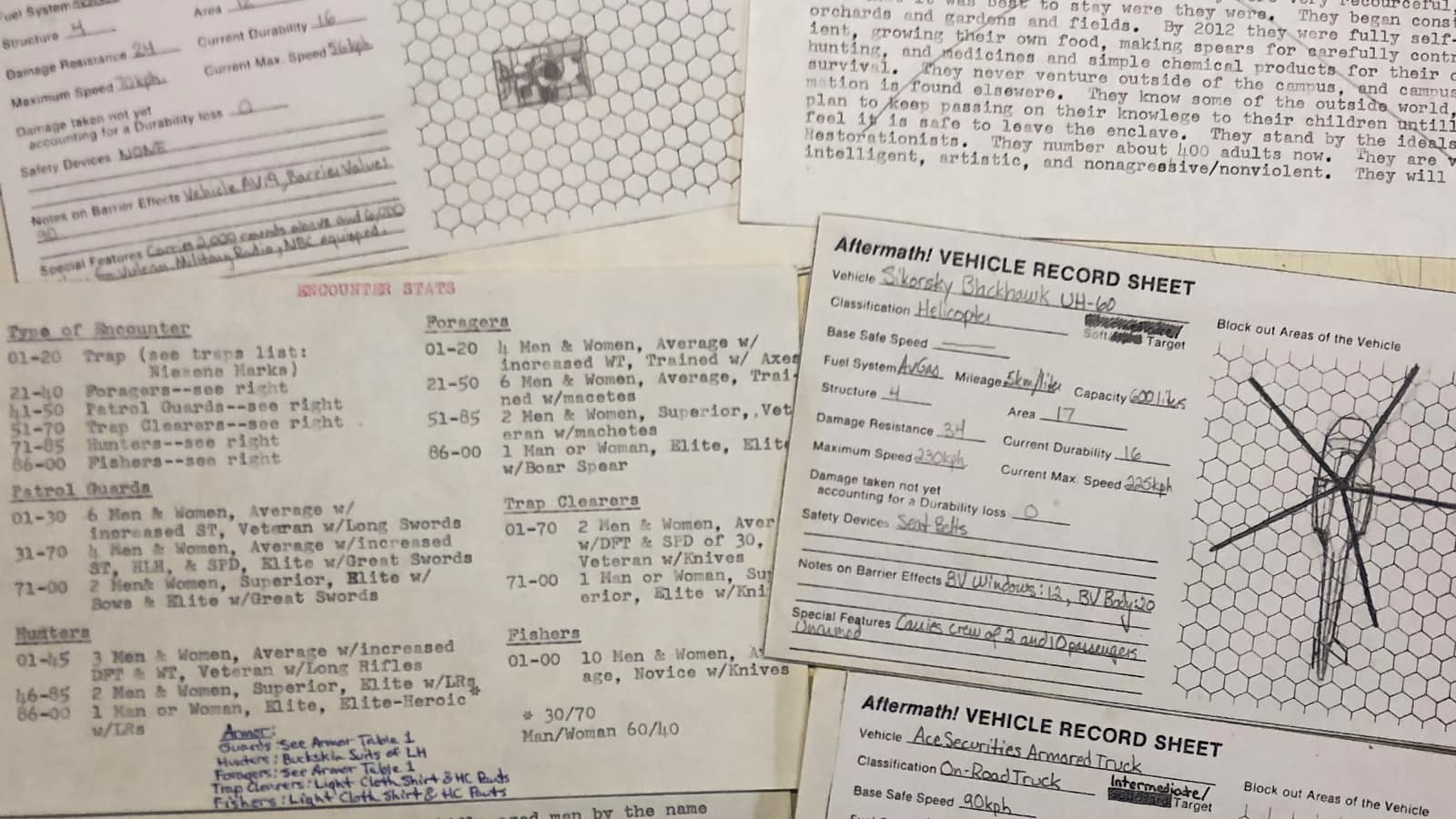
While the campaign also incorporated peaceful knowledge-preservers from the local college and university, as well as farmers and fisherfolk, they existed primarily to serve as victims to be defended from the depredations of the villains. Acquiring pre-Ruin weapons and using them to kill baddies was pretty much the name of the game.
At the time I didn’t know about the term verisimilitude – believability or appearance of truth, a feeling of realness. But if I’d known it, 15-year old me would have told you that Aftermath! provided the verisimilitude I wanted, primarily because of what I considered to be its realistic treatment of combat.
Realism ≠ Verisimilitude
Before I get into explaining the difference between realism and verisimilitude, let’s dispense with the idea that there are definitions for these terms that will satisfy all, most, or perhaps any readers. These are my interpretations of these terms, as they apply to my gaming experiences. And it’s important to note that they are borrowed from the arts and literature, respectively. As with so much of tabletop roleplaying terminology, we make do with inadequate terminology.
Caveats in hand, here’s how I think of realism: If I want to simulate the physics of the real world, of the earth we inhabit, the timeline we’re on, I want realism. A Formula 1 race car can hit speeds of up to 230 mph, but it can’t fly. If a soldier fires their AK-47 on full auto, its 30-round magazine will go empty in seconds. But soon as we start talking about alternate history, science fiction, or elves and magic, we’re out of the realm of realism. “How much damage would a dragon’s flame deliver?” isn’t a matter of realism.
Verisimilitude, on the other hand, is applicable to situations other than reality. It’s about making something that isn’t real feel real. The post-apocalyptic setting of my first Aftermath! campaign didn’t incorporate magic or trolls, but like a RuneQuest campaign, it wasn’t real. So it wasn’t providing realism. It was providing verisimilitude.
But verisimilitude is in the eye of the beholder. And life experience changed my understanding of what makes something made-up feel real. I came to realize that any mechanics that drill too far into the physics of gunplay are misrepresentations, because they present combat as a series of minute, deliberate, calibrated actions rather than as a stream of action-and-reaction. They also tend to model a coolly-detached, objective participation by PCs and NPCs.
I first encountered Coolness Under Fire rules in the first edition of Twilight: 2000 and they resonated immediately. Here’s the latest version, from the fourth edition (published by Free League):
If you are hit by enemy fire (even if the damage is fully deflected by armor or cover), or if one or more ammo dice in a failed attack against you show , you must immediately make a coolness under fire roll.
If your CUF roll fails, you are suppressed. This means that you immediately drop prone, suffer 1 point of stress, and lose both actions on your next turn.
If you fail a CUF roll and get suppressed, all friendly fighters in the same hex as you must also immediately make CUF rolls to avoid suppression too.
The Free League edition also incorporates a broader mechanism for accumulated Stress.
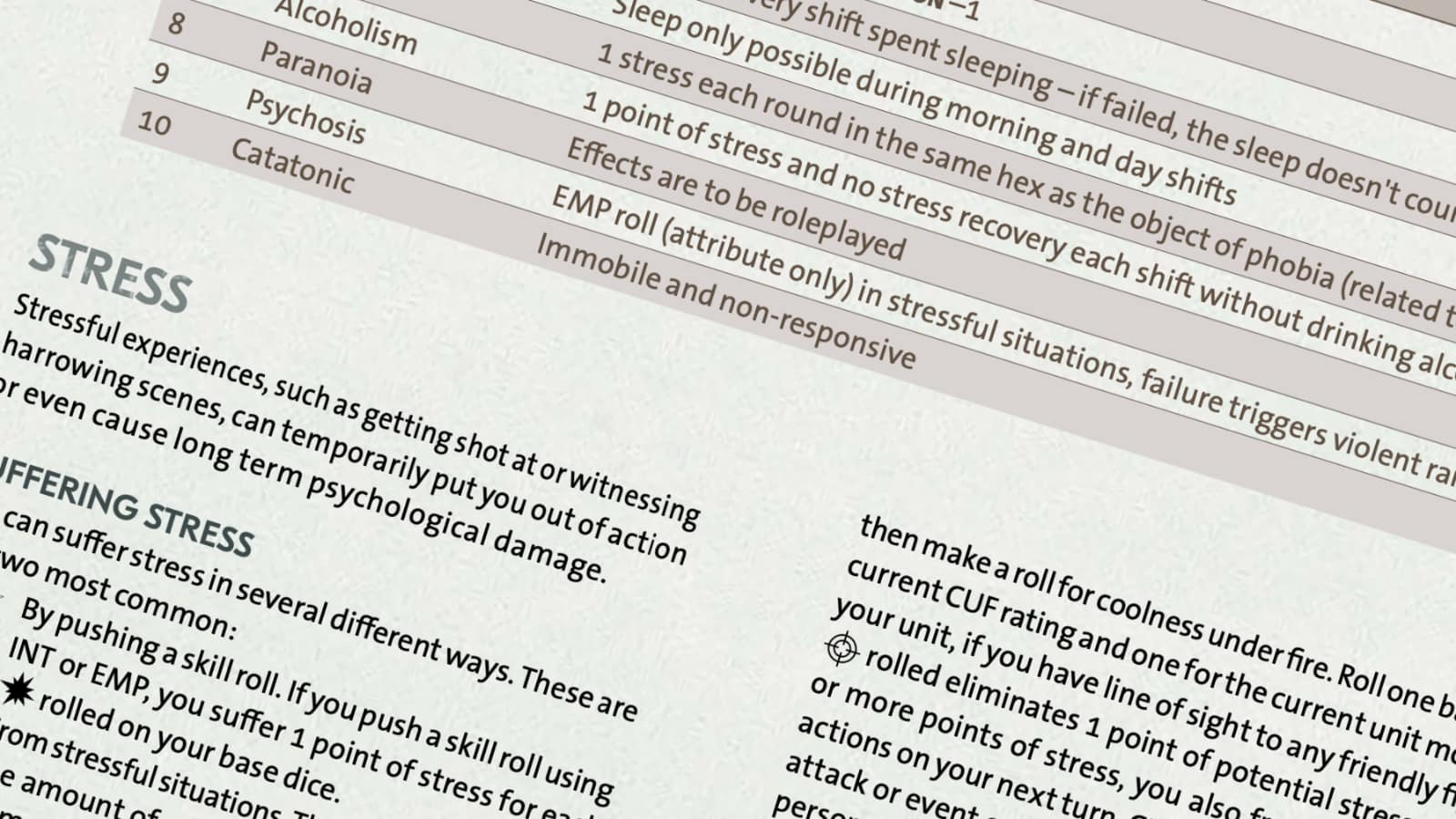
For a world in which normal humans are confronting the brutality of a gunfight, Coolness Under Fire and Stress rules are much more important in making that gunfight feel real than obsessing over the minute lethality differences between .40 caliber and 9mm rounds.
The Delta Green rules also incorporate long-term psychological effects in a way that feels right for a setting in which normal humans frequently have to kill or be killed. It adds up:
Killing other humans is inherently harmful to sanity. While wrestling and punching people is within biological norms, bludgeoning someone to death is not instinctive. The blasting noise and fire of modern violence overwhelm the human brain. Violence can drive you insane if you’re not careful.
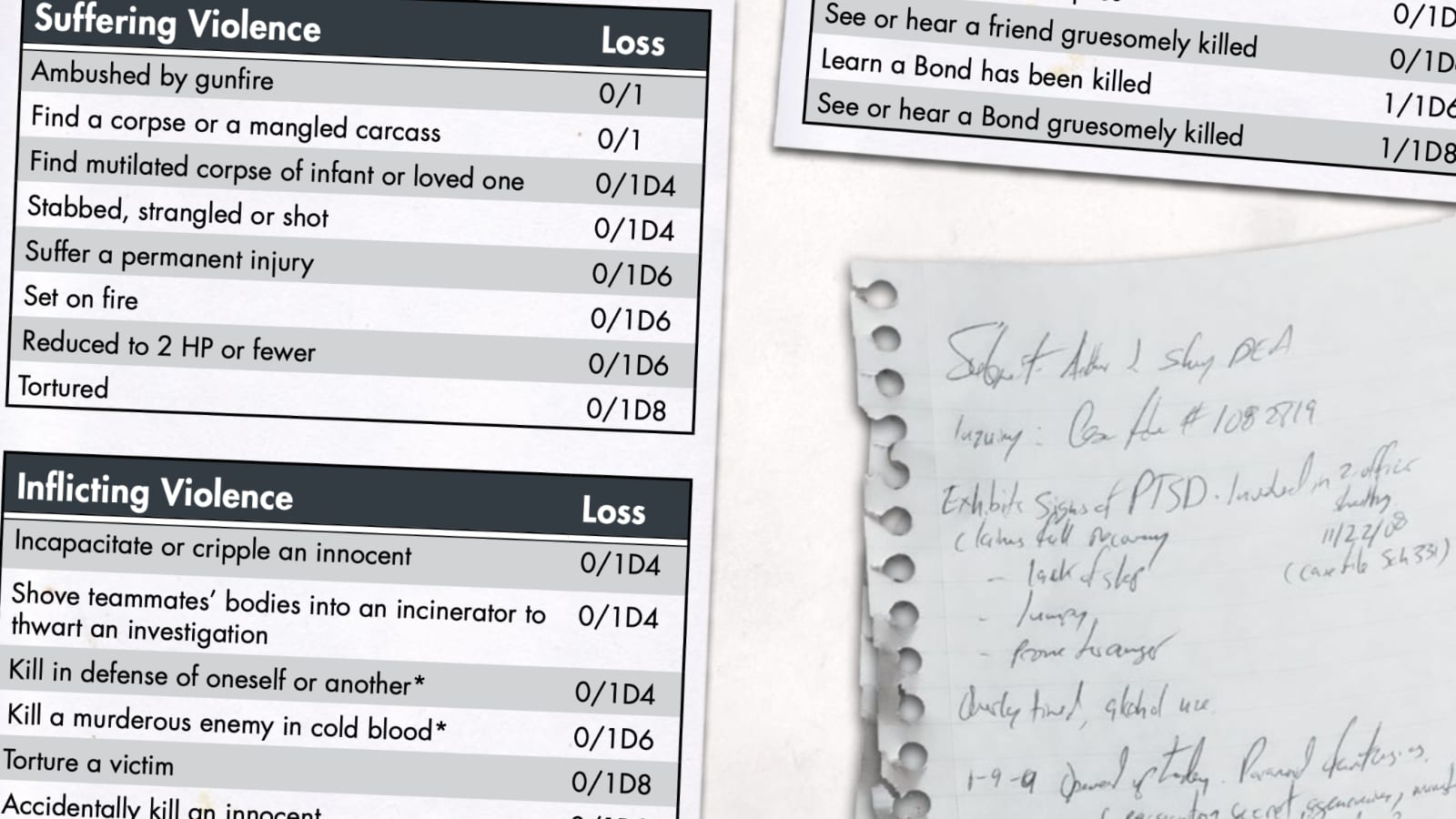
If I want to run a campaign in which player characters are not intended to be Hollywood-style action heroes, modeling ballistics in detail while glossing over the real but less visible effects on the human brain just doesn’t appeal to me any more.
The Social Limits of Violence
Random violence is actually far less prevalent than people think, and there’s a lot of evidence that this has always been the case. People have to be manipulated in order to feel that violence is acceptable, required, and necessary for group survival, even in war:
… it’s almost invariably necessary to employ some combination of ritual, drugs and psychological techniques to convince people, even adolescent males, to kill and injure each other in such systematic yet indiscriminate ways.
People who go around killing people for no reason or for reasons that don’t advance collective goals are a liability to group cohesion and therefore group survival. This applies to those who engage in inter-group as well as intra-group violence. Usually if you murder someone, their friends and relatives will exact retribution — the saying violence begets violence didn’t come from nowhere.
In my initial Aftermath! campaign I unconsciously modeled the D&D approach of rootless murder hobos who are unconnected to any social fabric in any meaningful way. One of the most revelatory things about RuneQuest is that since its incarnation in the early 80s, it has incorporated the concept that adventurers are never truly on their own — they are always connected not just to their fellow adventurers, but to cult, kin, and culture.
Looking back on that first Aftermath! campaign, it’s obvious that even though I’d already come to love RuneQuest, I couldn’t conceive of a post-holocaust world in which the imperatives of collective survival might make lone wanderers less common than genre fiction indicated. RuneQuest laid it out for me, but Aftermath! didn’t. And my adolescent mind didn’t have enough life experience to fill in the blanks.
This points to one of the best things about Free League’s Mutant: Year Zero. Yes, it is full of mutants with wings and mind powers, but it also posits that the PCs are part of a survivor community, and their success in the game is tied to how valuable their actions are to that community. It’s an elegant way to mechanically reduce the impulse for murder hoboism and to give the PC’s actions a higher purpose.
Context Matters
All of that said, violence is a pretty handy mechanism for ratcheting up the drama, and it’s part and and parcel of most tabletop RPGs. So it’s going to happen. I’ve just become more interested in the context around violence, the ramifications that play out in the larger drama of a campaign, than I was in my youth.
I still enjoy the cinematic, generally consequence-free violence of games like Star Wars (I’m currently running an Edge of the Empire campaign), The distinction in my mind is that for violence to have more profound psychological consequences in, for example, a Star Wars campaign would be jarring enough that it would no longer feel much like Star Wars.
This line of reasoning brings up an interesting point with regard to Andor. It’s a show that takes Star Wars into new territory by deliberately exploring what participants in a rebellion have to give up in order to achieve their goals. But it’s still Star Wars. Betraying friends is terrible. Leading a double life is terrible. But killing bad guys leaves no psychological wounds.
This is in keeping with prior Star Wars stories. Finn is repulsed at the killing innocents in The Force Awakens, and at the death of one of his squad-mates. But he kills a lot of Imperial soldiers thereafter, and doesn’t seem at all bothered by it. Star Wars has room for more nuance than it did in the past, but still only takes it so far.
So when I think about what feels “real” for a setting, there are always areas of emphasis and areas of omission. A campaign that purports to explore what it would be like to survive after an apocalypse without at least touching on the psychology of violence doesn’t feel right, nor would it feel right if PTSD from killing bad guys made Cassian Andor put down his blaster.
Ω
Note
The quote about the challenges of getting people to kill is from The Dawn of Everything: A New History of Humanity. You can find out more about the book in this UJ post.
